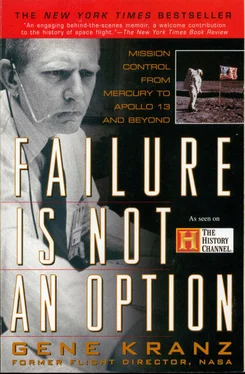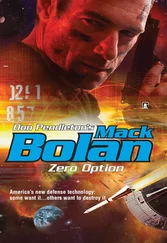The shock on my face must have registered as Kraft continued: “I’ll tell Paul Johnson to meet you at Mercury Control to give you a hand.” When Kraft talked, his eyes never left mine. I was given this assignment mainly because I was available. In this period of intensive development, jobs were open all over the place; NASA was forming organizations for mission planning, recovery operations, astronaut training, launch operations, and Mercury Control. Every new hire with the requisite technical and scientific credentials was put into a job slot the minute he came on board.
Kraft was one of the original thirty-six members of the Space Task Group, most of whom stepped forward to do a job that had never been done. He recognized that someone had to be in charge of the ground effort and he volunteered to lead that effort. A graduate of Virginia Polytechnic Institute, Chris had worked at Langley in the aircraft stability and control laboratory. My senior by nine years, he did not immediately impress me as a leader, the way some of my early mentors had. Kraft led a step at a time, and each Mercury mission added a new dimension to his presence and style.
My days as an observer were over, my chance to get up to speed ended. This was the first indication that my job slot would be in Mercury Control. Some people in Mercury Control had technical experience working on the tracking stations or at the Cape on the Vanguard, Explorer, and Pioneer missions. Others, like me, came from aircraft flight testing or were engineers from the pilotless aircraft research program at Langley. From my work, most recently at Holloman AFB in New Mexico, I knew about flying, systems, procedures, and checklists. I could figure out what a countdown should contain. Mission rules were different. There had never before been such a mission in U.S. history—I would just have to give it a shot. Since there were no books written on the actual methodology of space flight, we had to write them as we went along.
There was a relatively small group working down at Mercury Control, forty to fifty people. Some of them had grown up launching the early U.S. rockets derived from the German V-2 of the Second World War. Now, in a few months, we would attempt to send the first American into space. It was a scary thought, but not for anyone who had been around test pilots.
I had flown supersonic F-100s, which needed at least a mile to get off the runway on a good day. When you took off at 230 miles per hour, if the engine crapped out or you lost the afterburner, it could quickly become a bad day. But when you punched through the sound barrier it was a jolt of pure adrenaline. The SuperSabre looked like it was more than capable of carrying out its air superiority mission. But you had better be ready when you strapped yourself in. No matter how skilled you were in handling it, you were never sure when the elements or the aircraft, in a perverse way, would decide to test you. Every time I climbed aboard I could feel the thrill of tension and anticipation.
At Holloman AFB, where I had worked as a flight test engineer, we had been putting people into scary situations for years. It was not unusual for a guy to climb to an altitude of 100,000 feet in a balloon and then bail out in a parachute, falling 90,000 feet before his parachute opened. This was the environment of risk and these were the kinds of people who had been picked as the Mercury Seven astronauts.
Looking back, I can see now how minimal, even primitive, our facilities were at the time, both in the control center and in the blockhouse—a massively reinforced structure placed as close as prudently possible to the launch pad where the guys who were responsible for the actual functioning of the rocket manned their posts. We tended to talk about “the Germans in the blockhouse” largely because Wernher von Braun and his cohorts, who had worked on the rocket programs, came to the United States after Germany’s defeat in World War II. They were originally stationed near El Paso, Texas, and tested captured V-2 rockets for the military at the White Sands, New Mexico, test range. Later they were moved to permanent facilities at Huntsville, Alabama, and worked for the Army Redstone Arsenal. Most of the Germans became American citizens, adopting Huntsville as their home. In 1960 rocket development at the Redstone Arsenal was transferred to the newly formed Marshall Space Flight Center (MSFC), and von Braun, along with nearly 100 other German scientists and technicians, began work on a powerful series of rockets called Saturn I.
At this point in the space program, our communications network was actually run out of NASA’s Goddard Space Flight Center in Greenbelt, Maryland. It had been named after Dr. Robert Goddard, the American pioneer in rocketry, who had developed rocket engine and guidance technology in the 1930s equal, if not superior in some respects, to what von Braun and his colleagues were working on as late as 1945. Goddard, one of my boyhood heroes, had had the backing of Charles Lindbergh, which enabled him to test his rockets in New Mexico, not far from the site where von Braun and his Germans would fire the first captured V-2 rockets in the late 1940s and test those that evolved from V-2 technology in the years that followed.
The German scientists and technicians would come back to the Cape occasionally for selected launches (particularly high-profile manned missions), but they had their hands full at Marshall developing a new generation of rockets. By the time NASA launch operations were forming up, American engineers were well acquainted with rockets, building on the experience of the Germans, as were the contractors producing the Redstone and Atlas missiles. While the new generation of American scientists and engineers was now doing the job, the first boosters in the manned spaceflight effort were barely adequate, as events would demonstrate. In many ways this technology was as “out on a limb” as Charles Lindbergh’s Ryan monoplane. He didn’t have any manuals either, and his facilities were primitive. Roosevelt Field in 1927 and Canaveral in 1960 had a few things in common. The massive Cape facility that would grow up in the next decade and soon become the Kennedy Space Center (which would include the largest enclosed space in the world, the vertical assembly building) was beyond our wildest dreams at the time.
In 1960 the Cape looked like an oil field, with towering structures, dirt, and asphalt roads newly carved out of the palmetto scrub. The alligators were reluctantly surrendering to the onslaught of newly arrived civilization. If you didn’t have a good sense of direction you were in trouble. There were few directional signs and once you got off the road visibility narrowed. At night you could easily imagine the gators and snakes taking their revenge on any intruder foolish enough to be wandering around on foot, lost in the boondocks.
The man in space program was simple in concept, difficult in execution. Every mission was a first, a new chapter in the book. Many, if not most, of the components in both rockets and capsules had to be invented and handmade as we went along, adapting what we could from existing aviation and rocket engine technology. Before putting a man on top of a rocket, we would first fly one or two tests with a “mechanical man,” a box full of electronics weighing about as much as an astronaut to simulate the conditions that would be present when an astronaut was on board the capsule. The capsule would send back some prerecorded messages to test our communications. Then we graduated to spider monkeys—and then to chimpanzees, working our way up the evolutionary ladder, so to speak. The missions were initially to be twenty-minute lob shots, using the Army’s Redstone rocket; then we would go into orbit with the Air Force’s first-generation Atlas intercontinental missiles. The military boosters were barely ready for operational use. Here the missile gap was indeed real—except the gap was between what the hardware was supposed to do and what it had shown it could do.
Читать дальше












